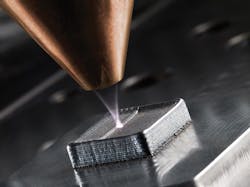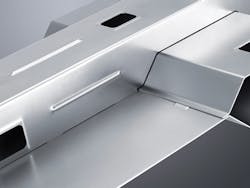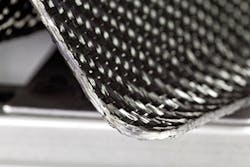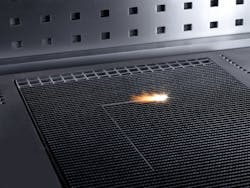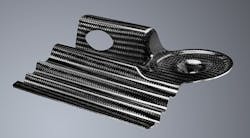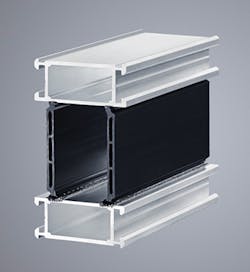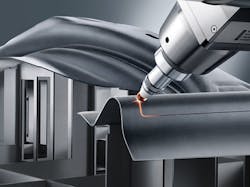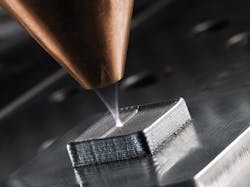How laser technology enables car efficiency
Laser processes assist in flexible manufacturing of lightweight auto bodies
RALF KIMMEL
Laser technology is an important key to reducing CO2 emissions in passenger cars. A multitude of laser-based innovations for automobile production contribute to achieving this goal, and this article provides an overview of them.
Future generations of vehicles will be far lighter than their predecessors, and laser-based manufacturing processes play an important part in this progress. Examples include parts without flanges; the increasing use of aluminum, carbon fiber-reinforced plastic (CFRP), and other high-performance plastics; and thermoforming and joining plastics to metals. These innovations help to reduce vehicle weight, which in turn extends the cruising range and lessens CO2 emissions.
Lightweight vehicle construction, thanks to lasers
When joining metal sheets with conventional spot welding, it is necessary to overlap the edges. By comparison, welding with a laser beam makes possible flangeless designs. Here, the individual sheets are first assembled by use of tongue-and-groove joints and then welded by the laser. This offers several advantages: processing time drops when compared with spot welding; the joined elements can be of differing materials and thicknesses; and the resulting structures have no redundant material and thus save weight (FIGURE 1). In addition, prepositioning of one part to another reduces the otherwise enormous effort for clamping technology, permitting simple and cost-favorable clamping aids.
Where greater loads demand additional stability, reinforcing structures can be attached as needed. Corresponding structures—such as the underbody of a vehicle—can be created with less tooling. And special tools are not required for this purpose, which would have had to be manufactured in an elaborate process when preparing for production. Instead, all the required steps in processing can be carried out by a standard laser welding robot.
One outstanding example of this process is the "StreetScooter" deployed by the German Post Office. It was engineered by an academic spinoff of the Rhenish-Westphalian Technical University (Aachen, Germany), and is built on an underbody created without flanges. At present, about 40 of these microvans are in trial use—and have been thoroughly successful to date.
Using lasers permits innovative mixes of materials
Carbon fiber-reinforced plastic is also being used more frequently in lightweight vehicle engineering, especially in vehicles powered solely by electricity. Laser technology offers clear advantages when cutting and processing materials like this. In this way, incisions are made without touching the material or exerting any force whatsoever, ensuring that the shape and structure of the material remain unchanged. This eliminates the risk of warping, even in non-reinforced materials. Depending on the production process being used, cutting and processing can take place either before or after the CFRP parts have been shaped (FIGURE 2). When cutting blanks from carbon fiber materials, TRUMPF offers its TruFiber laser systems equipped with TruDisk spatially shaped beam sources for cutting 3D parts. If CFRP, a glass, or carbon fiber mat—already embedded in the binder—is to be cut, then this laser system is an excellent choice (FIGURE 3). Here, the laser melts away the fibers cleanly (FIGURE 4).
Another way to improve the production processes using laser technology is thermal joining of plastics to metallic materials without the use of adhesives. Since metals and plastics have widely differing melting points, this would not be possible with traditional welding technology. However, using a short-pulse laser makes it possible to create a defined pattern of undercuts in the metal, into which the heated partner made of plastic is pressed. Once the plastic has cooled and hardened, the two materials are joined by a form-fit connection (FIGURE 5). Examinations of the tensile strengths in such connections show that the union attains the strength of the basic material. Connections made this way are pressure- and waterproof, and remain stable even under dynamic loading.
The use of lasers in hot forming
Hot stamping processes allow for considerable reductions in the weight of body parts. However, the hardened steels are too strong to be cut in a press. Laser technology presents an elegant solution for this problem, too. The parts are cut using 3D laser cutting, without wear and without applying force (FIGURE 6). This tremendously productive technology can also be used for 2D cutting of the feedstock material prior to it being shaped in the press. Here, optimized cutting patterns can save material. If model facelifts or derivatives require subsequent modifications, these can be affected simply by reprogramming the laser robot. No new punching tools need to be engineered and manufactured.
Conversely, laser light can also be used to induce partial softening to improve the formability in a closely defined area, or to reduce the hazard of the material becoming brittle or breaking. The RF generators offered by TRUMPF are ideal for this purpose.
The beam of a laser can also be used to remove coatings from areas in the steel sheet in preparation for later welding. One example is ablating an aluminum-silicon coating that measures 10–25μm thick. The process can be regulated so finely that the amount of aluminum remaining is exactly adjusted, enabling precise control of the material properties. The laser systems used here, such as the TRUMPF TruMicro series, can undertake the ablation described with a velocity greater than 30m/min.
In following phases in the work, lasers can also apply lettering, marks, QR codes, and the like. And lasers also serve to subsequently weld parts prepared by thermoforming.
Opening the way for new production processes
Even other approaches are offered by techniques known as laser metal fusion (LMF) and laser metal deposition (LMD). Both processes are based on concepts such as those made familiar by 3D printing and additive manufacturing. They make it possible to produce parts that could not be manufactured at all with conventional processes. Complexity is for free—and this is true both in regard to their shape and the properties of the materials, especially since these innovative processes permit combining differing materials within a single workpiece.
In LMF, an extremely fine metallic powder is applied uniformly to a metallic substrate and then melted or fused selectively with laser energy and allowed to harden. When using this process to create a workpiece, the 3D engineering data are "sliced" into individual layers 20–100μm thick. The 2D image of each layer is the basis for the additive build-up of the workpiece. Exact control of the laser makes it possible to fuse each new layer of powder to the layers below—at the desired places and at the required material thickness.
In the case of LMD, the laser beam generates a weld pool on a metallic substrate, into which another material such as titanium, nickel, cobalt, tungsten carbide, or steel alloy is introduced as a powder. The powder melts and forms a layer, which then coalesces with the substrate. LMD even makes it possible to create multi-layer workpieces, which—if desired—can comprise several different bonded alloys (FIGURE 7).
The additive processes described here are already available today and in the coming years may be on par with conventional processes from an economic point of view. They can, by the way, also be used to apply structural reinforcements or additional structures to workpieces manufactured with other techniques. This adds flexibility to production processes in regard to the placement, geometry, and size of the supplementary structure. And since additional material is attached only wherever it is really necessary, this technique once against saves weight in the finished part.
Perspectives for novel concepts
Even the processes introduced up to this point by no means exhaust the options for using laser technology in vehicle engineering. Rather, they form the basis for numerous novel concepts. Only a single example is described at this juncture.
Remote fillet welding makes it possible to weld two workpieces at an overlapped seam. When compared with laser welding normally used today, the amount of material can be further reduced by shortening the flanges in the overlapping zone. The seam is then welded by the laser beam directly in the created fillet, requiring no additional filler material. One example of an application is welding seams in the frames for vehicle doors.
This process does, however, require the highest positioning accuracy for the laser beam. This can be achieved by using appropriate sensors to register the orientation of the workpiece and continuously re-regulate the position of the laser beam.
Conclusion
Laser-based processes make it possible to produce vehicle bodies with lower weights and do so in different ways. This makes laser processing an important advance along the way to reducing emission levels, increasing cruising ranges and, beyond this, to speed up, reduce cost, and add flexibility to automotive production.
RALF KIMMEL([email protected]) is with Industry Management Automotive for TRUMPF Laser und Systemtechnik, Ditzingen, Germany, www.trumpf.com/en.
